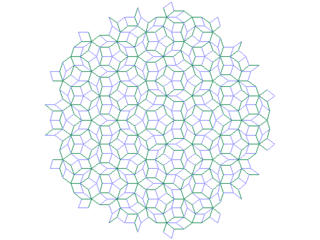Penrose tiling
|
|
A Penrose tiling is pattern of tiles, discovered by Roger Penrose and Robert Ammann, which could completely cover an infinite plane, but only in a pattern which is non-repeating (aperiodic).
There are several different sets of Penrose tiles; the image above displays one of the more commonly encountered sets. (There are a number of ways to generate such images; this was generated using an L-system.) It consists of two tiles, each having four sides with a length of one unit. Both tiles are connected to golden section.
- One tile, known as the thick rhombus, has four corners with the angles {72, 72, 108, 108} degrees.
- The other tile is the thin rhombus with angles of {36, 36, 144, 144} degrees.
In other words, the angles are one tenth of a circle (36 degrees) times {2,2,3,3} and {1,1,4,4}.
The tiles are put together with one rule: no two tiles can be touching so as to form a single parallelogram. The tiles can be modified with bumps and dents around the perimeter to enforce this rule, but the tiling looks better if they have smooth sides.
Penrose7.gif
Given this rule, there are many ways (in fact, uncountably many ways) to tile an infinite plane with no gaps or holes, but the tiling is always guaranteed to be aperiodic. This means that the pattern never repeats exactly. However, given a bounded region of the pattern, no matter how large, that region will be repeated an infinite number of times within the tiling (and, in fact, in any other Penrose tiling).
That it must be possible to tile the plane aperiodically was first proven as a general proposition in 1966 by Robert Berger, who shortly thereafter invented the first aperiodic set of tiles, consisting of 20426 distinct tile shapes. The number of shapes in a set of aperiodic tiles was quickly reduced by others, reaching its current pinnacle in Penrose tiles, the smallest sets of which require only two different shapes. It is unknown whether any single-shape sets exist that can tile the plane aperiodically but can not periodically.
Aperiodic tiling was first considered only an interesting mathematical structure, but physical materials were later found where the atoms were arranged in the same pattern as a Penrose tiling. This pattern is not periodic (repeating exactly) but it is quasiperiodic (almost repeating), so the materials were named quasicrystals. See quasicrystal for more on these materials, and on the mathematics of quasiperiodic patterns.
References
- Penrose, Roger. (1989) The Emperor's New Mind. ISBN 0-198-51973-7
- Penrose, Roger, Template:US patent "Set of tiles for covering a surface," patent issued January 9, 1979
- Gardner, Martin. "Penrose Tiles", chapter 7 in his book The Colossal Book of Mathematics. ISBN 0-393-02023-1
External links
- A free Microsoft Windows program to generate and explore rhombic Penrose tiling (http://www.stephencollins.net/Web/Penrose/Default.aspx). The software was written by Stephen Collins of JKS Software, in collaboration with the Universities of York, UK and Tsuka, Japan.
- Instructions for making the Penrose tiles (http://www.cs.uidaho.edu/~casey931/puzzle/penrose/penrose.html)
- Toilet Paper Plagiarism (http://www.parascope.com/articles/slips/fs_151.htm)
- Two theories for the formation of quasicrystals resembling Penrose tilings (http://www.sciencenews.org/sn_arch/10_12_96/bob1.htm)it:Tassellatura di Penrose

